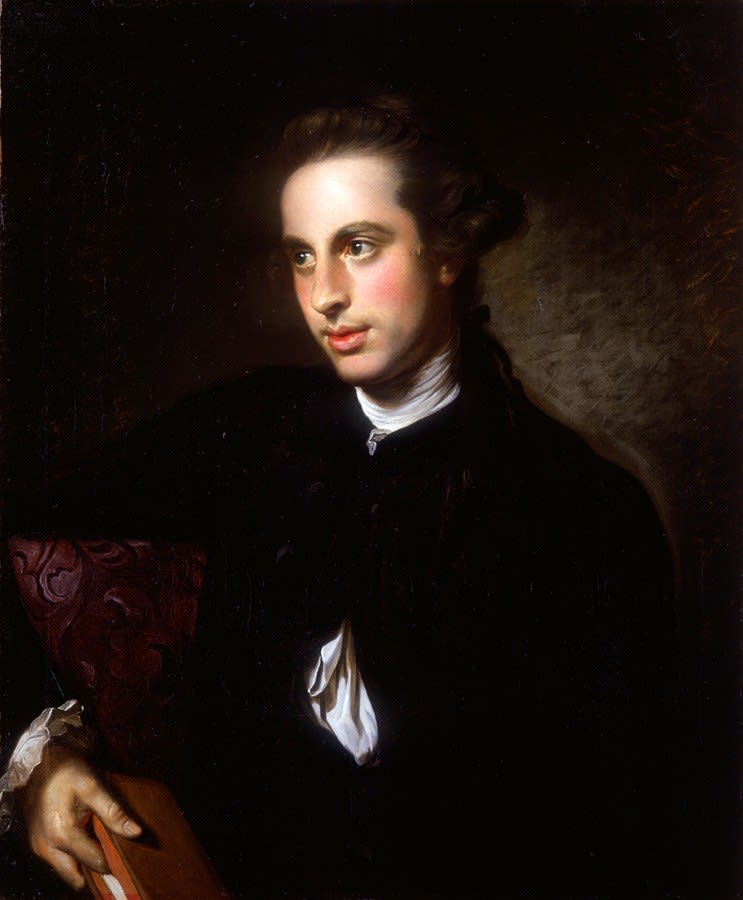
Sir Nathaniel Dance-Holland
Portrait of George Hardinge MP KC (1743-1816), c. 1775
Oil on canvas
30 ¼ x 25 ¼ in. (76.8 x 64.2 cm)
Philip Mould & Co.
To view all current artworks for sale visit philipmould.com George Hardinge was an English renaissance man. Aside from being a poet and author he was also a Member of...
To view all current artworks for sale visit philipmould.com
George Hardinge was an English renaissance man. Aside from being a poet and author he was also a Member of Parliament, and a highly regarded lawyer, most notably as Queen Charlotte’s attorney-general from 1794 until his death in 1816. Lord Camden, the Lord Chancellor, wrote in 1783 “…in language wit and voice he has no superior at the bar.” [Camden writing in December 1783, quote in History of Parliament, House of Commons 1754-90, Namier & Brooke, London 1985].
To Hardinge himself it was a political career and literary endeavour, far more than the law, which provided the greatest satisfaction. In the Commons, he was a member for that famous rotten borough, Old Sarum (electorate, 2), holding the seat continuously from 1784 until it was ‘sold’ in 1802. He was, ironically, a continuous advocate of Parliamentary reform throughout the period. And yet, for all his undoubted and admired skills, Hardinge was evidently seen as a peculiar man by his contemporaries, who could not decide whether to admire him for his aesthetic and literary passions, or his political and legal skill. His obituary described him thus;
“So various were his powers that he was a judge, a Member of Parliament, a poet, a prose writer, and a writer of sermons. He occasionally exhibited great eleoquence; no one had a finer choice of words and few a more graceful delivery. His voice was also sonorous, his imagery rich and classical, his narrative clear and perspicacious. He was possessed of abilities of the highest order, and great expectations were formed of his career in the legal profession, but his natural indolence, blended with his intense regard for poetry, doomed these to failure.” [Annual Biography and Obituary, 1817, volume 1, p. 299].
The sentiments of Hardinge’s obituary are sumptuously conveyed in this touching portrait by his close friend Nathaniel Dance. Here, even the most cursory glance reveals Hardinge as a man easily lost in the realms of literature, with his clothes casually open, a book in his hand, and an expression of quiet revelation. Hardinge sat for Nathaniel Dance on two occasions, and this example is clearly the more intimate of the two, not least in its unfinished state, which itself is a further indication of friendship. Dance’s other portrait, larger and more formal, shows Hardinge the lawyer and politician, and was exhibited at the Royal Academy in 1769, the same year as that Dance’s exquisite full length of Queen Charlotte.
George Hardinge was an English renaissance man. Aside from being a poet and author he was also a Member of Parliament, and a highly regarded lawyer, most notably as Queen Charlotte’s attorney-general from 1794 until his death in 1816. Lord Camden, the Lord Chancellor, wrote in 1783 “…in language wit and voice he has no superior at the bar.” [Camden writing in December 1783, quote in History of Parliament, House of Commons 1754-90, Namier & Brooke, London 1985].
To Hardinge himself it was a political career and literary endeavour, far more than the law, which provided the greatest satisfaction. In the Commons, he was a member for that famous rotten borough, Old Sarum (electorate, 2), holding the seat continuously from 1784 until it was ‘sold’ in 1802. He was, ironically, a continuous advocate of Parliamentary reform throughout the period. And yet, for all his undoubted and admired skills, Hardinge was evidently seen as a peculiar man by his contemporaries, who could not decide whether to admire him for his aesthetic and literary passions, or his political and legal skill. His obituary described him thus;
“So various were his powers that he was a judge, a Member of Parliament, a poet, a prose writer, and a writer of sermons. He occasionally exhibited great eleoquence; no one had a finer choice of words and few a more graceful delivery. His voice was also sonorous, his imagery rich and classical, his narrative clear and perspicacious. He was possessed of abilities of the highest order, and great expectations were formed of his career in the legal profession, but his natural indolence, blended with his intense regard for poetry, doomed these to failure.” [Annual Biography and Obituary, 1817, volume 1, p. 299].
The sentiments of Hardinge’s obituary are sumptuously conveyed in this touching portrait by his close friend Nathaniel Dance. Here, even the most cursory glance reveals Hardinge as a man easily lost in the realms of literature, with his clothes casually open, a book in his hand, and an expression of quiet revelation. Hardinge sat for Nathaniel Dance on two occasions, and this example is clearly the more intimate of the two, not least in its unfinished state, which itself is a further indication of friendship. Dance’s other portrait, larger and more formal, shows Hardinge the lawyer and politician, and was exhibited at the Royal Academy in 1769, the same year as that Dance’s exquisite full length of Queen Charlotte.